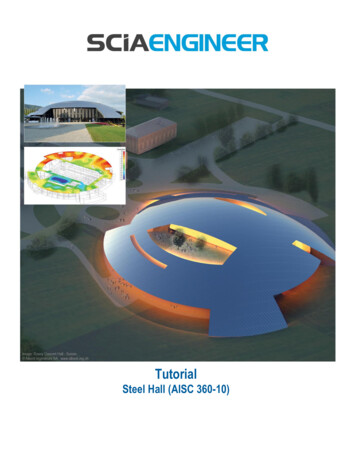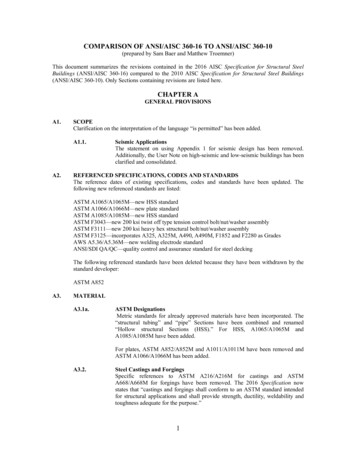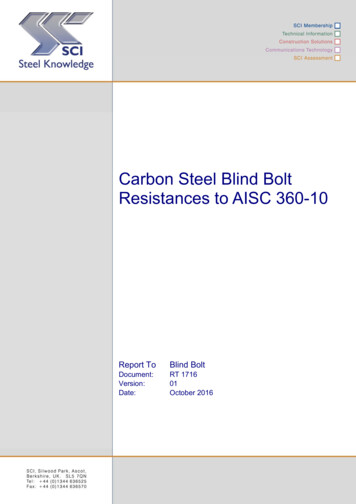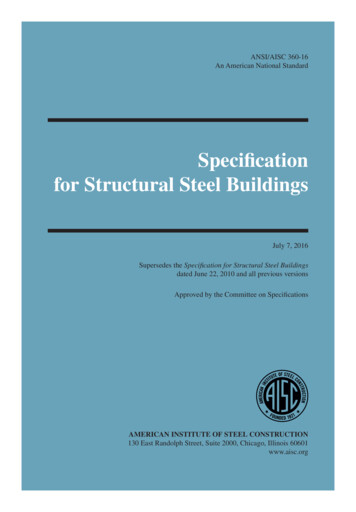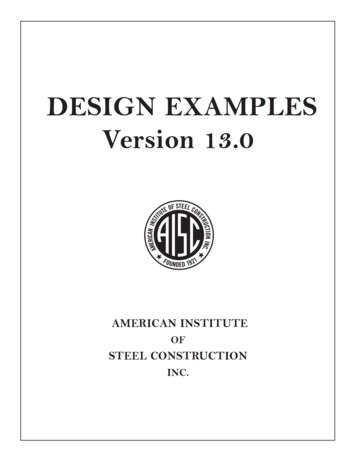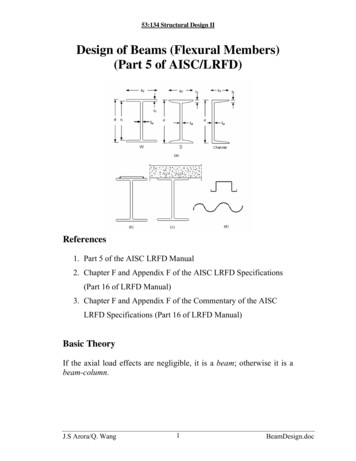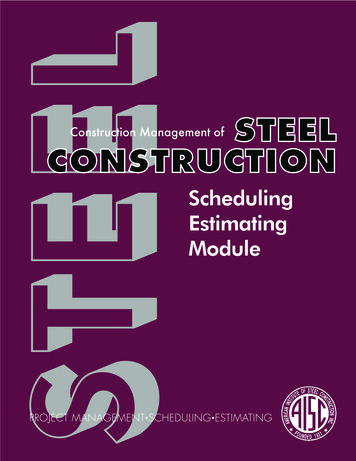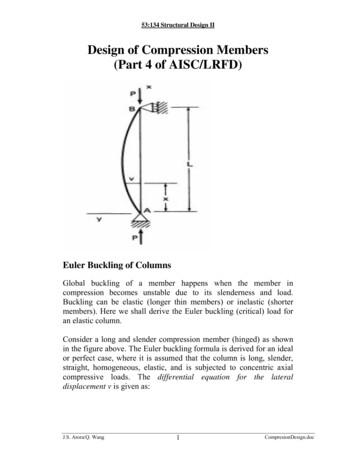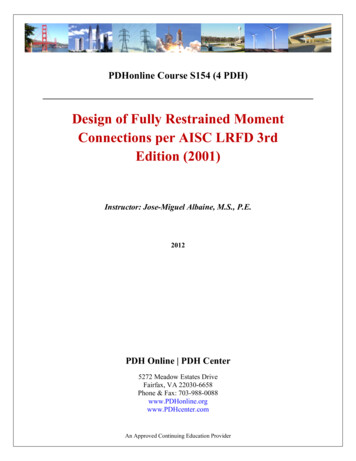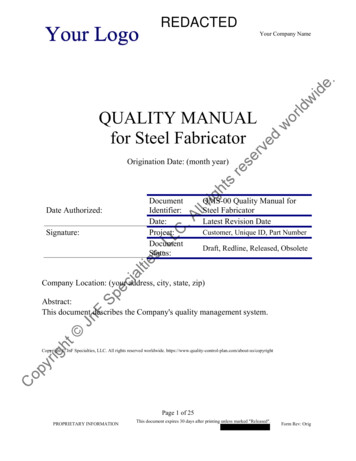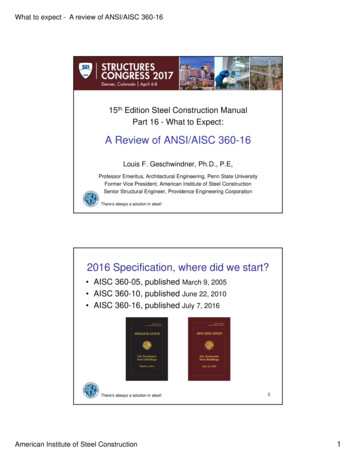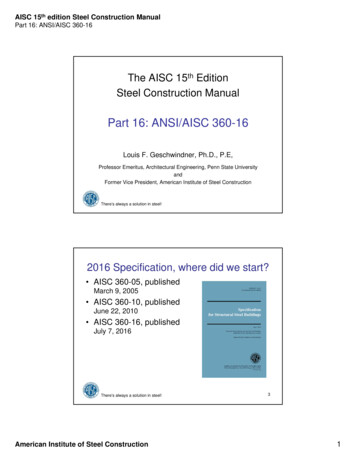
Transcription
AISC 15th edition Steel Construction ManualPart 16: ANSI/AISC 360-16The AISC 15th EditionSteel Construction ManualPart 16: ANSI/AISC 360-16Louis F. Geschwindner, Ph.D., P.E,Professor Emeritus, Architectural Engineering, Penn State UniversityandFormer Vice President, American Institute of Steel ConstructionThere’s always a solution in steel!2016 Specification, where did we start? AISC 360-05, publishedMarch 9, 2005 AISC 360-10, publishedJune 22, 2010 AISC 360-16, publishedJuly 7, 2016There’s always a solution in steel!American Institute of Steel Construction31
AISC 15th edition Steel Construction ManualPart 16: ANSI/AISC 360-162016 Specification, what can youexpect? AISC’s continued commitment to a singlespecification for all types of elements. Continued availability of provisions forLRFD and ASD (a unified specification)Ru Rn and Ra Rn Some expansion but overall, minimalchange.There’s always a solution in steel!4What was the goal for 2016? To again produce a specification that reflectsminimal change from previous editions. Implement only essential changes. Continue to coordinate with all AISC standards Integrate with non AISC standards such asASCE 7, IBC, and ACI. Reference appropriate other newly approvedstandards.There’s always a solution in steel!American Institute of Steel Construction52
AISC 15th edition Steel Construction ManualPart 16: ANSI/AISC 360-162016 AISC Specification Basic organization has not changed– Still 14 Chapters, A through N– Still 8 Appendices, 1 through 8 Within some chapters, provisions havebeen reorganized Throughout there have been editorialchanges that will not be discussed hereThere’s always a solution in steel!6Chapter A General Provisions A3. Material– Tubing and pipe are now combined underSection A3.1a(b) Hollow Structural Sections(HSS) ASTM A1065, 50 ksi welded HSS added ASTM A1085, new HSS standard with tightertolerances added– ASTM A1066, HSLA plate produced bythermo-mechanical controlled process added Grades 50 to 80There’s always a solution in steel!American Institute of Steel Construction73
AISC 15th edition Steel Construction ManualPart 16: ANSI/AISC 360-16Chapter A General Provisions A3.3 Bolts, washers and nuts– ASTM F3125 added. It includes the formerA325 and A490 type standards as grades.– Thus, ASTM A325, A490, F1852, and F2280no longer exist as separate standards.– ASTM F3111 and F3040, 200 ksi hex headand twist-off bolts are added as Group C.These are proprietary productsThere’s always a solution in steel!8Chapter B DesignRequirements B3. Design Basis– This section has been completely reorganized– It provides the charging language for theremainder of the Specification in this neworder:1. Design by LRFD2. Design by ASD3. Required Strength4. Design of Connections and Supports5. Design of Diaphragms and CollectorsThere’s always a solution in steel!American Institute of Steel Construction94
AISC 15th edition Steel Construction ManualPart 16: ANSI/AISC 360-16Chapter B DesignRequirements B3. Design Basis6. Design of Anchorages to Concrete7. Design for Stability8. Design for Serviceability9. Design for Structural Integrity – new provisions10. Design for Ponding – revised provisions11. Design for Fatigue12. Design for Fire Conditions13. Design for Corrosion EffectsThere’s always a solution in steel!10Chapter B DesignRequirements B3.9 Design for Structural Integrity– When required by applicable building code(a) Column splice tensile strength(b) Beam end connection tension strength(c) Bracing connection tensile strengthStrength requirements for structural integrity evaluatedindependently of other strength requirements.There’s always a solution in steel!American Institute of Steel Construction115
AISC 15th edition Steel Construction ManualPart 16: ANSI/AISC 360-16Chapter B DesignRequirements B3.10 Design for Ponding– Requirement regarding minimum roof slope toavoid ponding analysis is removed.– Now requires that stability for ponding bechecked unless roof surface is configured toprevent the accumulation of water.– Appendix 2 is referenced and there theassumptions for use of the two approachesare defined.There’s always a solution in steel!12Chapter B DesignRequirements B4.2 Design Wall Thickness for HSS– Two new material specifications, ASTMA1065 and A1085. Both permit use of nominal thickness as designwall thickness A1085 – an HSS standard with tighter tolerancesthan A500 etc. A1065 – 50 ksi plate material produced to astandard with typical plate tolerances.There’s always a solution in steel!American Institute of Steel Construction136
AISC 15th edition Steel Construction ManualPart 16: ANSI/AISC 360-16Chapter B DesignRequirements B4.2 Design Wall Thickness for HSSUser Note: A pipe can be designed using theprovisions of the Specification for round HSSsections as long as the pipe conforms to ASTMA53 Class B and the appropriate limitations ofthe Specification are used.There’s always a solution in steel!14Chapter C Design for Stability C2.2 Consideration of Initial SystemImperfections– System Imperfections Imperfections in location of points of intersection ofmembers (column out-of-plumbness)– Member Imperfections User note now makes it clear that these arealready taken into account in the column equationsfrom Chapter E. (column out-of-straightness)There’s always a solution in steel!American Institute of Steel Construction157
AISC 15th edition Steel Construction ManualPart 16: ANSI/AISC 360-16Chapter C Design for Stability C2.3(b) Adjustments to Stiffness– Flexural stiffness reduction factor, τb, nowdefined for composite members (in Chapter I)– Also redefined for members with slenderelements b 4 Pr Pns 1 Pr Pns (C2-2b) For nonslender element sections Pns Fy Ag For slender element sections Pns Fy AeThere’s always a solution in steel!16Chapter C Design for Stability K-factor– First introduced in the 1963 Specification– Set equal to 1.0 when using the direct analysismethod of Chapter C (since 2005)– For 2016, KL, the effective length, has been replacedwith Lc . This makes the designation of effectivelength simpler since in some instances, such as fortorsion, the traditional definition of K is not helpful.– This has been implemented throughout the 2016SpecificationThere’s always a solution in steel!American Institute of Steel Construction178
AISC 15th edition Steel Construction ManualPart 16: ANSI/AISC 360-16Chapter D Tension The only change in this chapter has to dowith shear lag for longitudinally weldedconnections to tension members. Case 2 no longer applies to weldedconnections unless they use transversewelds in combination with longitudinalwelds.18There’s always a solution in steel!Chapter D Tension Thus, Case 4 has been expanded toinclude shapes as well as plates and theshear lag factor equation revised.Case 4: Plates, angles, channels with welds at heels,tees, and W-shapes with connected elements, wherethe tension load is transmitted by longitudinal weldsonlyl1U 3l 2 x 1 3l 2 w2 l Tl There’s always a solution in steel!American Institute of Steel ConstructionPlate orConnected Elementwl1 l22Tl2199
AISC 15th edition Steel Construction ManualPart 16: ANSI/AISC 360-16Chapter E Compression E4. Torsional and Flexural-Torsional Buckling ofSingle Angles and Members without SlenderElements– Consider what to do when twisting is not about theshear center.– Deleted the special case for double angles and tees.– Clarified that this section applies to single angles withb t 0.71 E Fy(This had been b/t 20 in 2010)There’s always a solution in steel!20Chapter E Compression E5. Single Angle Compression Members– Clarified that flexural-torsional buckling need not beconsidered for b t 0.71 E Fy E6. Built-up members– Clarified need for Class A or B faying surfaces insome situations. E7. Members with Slender Elements– Completely revised the approach and made it similarto AISI approach.There’s always a solution in steel!American Institute of Steel Construction2110
AISC 15th edition Steel Construction ManualPart 16: ANSI/AISC 360-16Chapter E Compression E7. Members with Slender Elements– Stiffened and unstiffened elements treatedsimilarly (same effective width equation)– The critical stress is the same, regardless ofelement slenderness (E3-2, E3-3)– Slender element comes into play througheffective areaPn Fcr Ae(E7-1)22There’s always a solution in steel!Chapter E Compression E7. Members with Slender Elements– when rFyFcrbe bThere’s always a solution in steel!American Institute of Steel Construction(E7-2)2311
AISC 15th edition Steel Construction ManualPart 16: ANSI/AISC 360-16Chapter E Compression E7. Members with Slender Elements– when rFyFcr F Fbe b 1 c1 el elFcr Fcr (E7-3)2 Fel c2 r Fy There’s always a solution in steel!(E7-4)24Chapter E Compression1 1 4c1c2 Table E7-12c1Effective Width Imperfection Adjustment Factor, c1and c2 Factor.CaseSlender Elementc1c2(a)Stiffened elements except walls of square and rectangular HSS0.181.31(b)Walls of square and rectangular HSS0.201.38(c)All other elements0.221.49 r c3kc EFyThere are 6 distinct values for c3, found in Table B4.1akc 1 except for flanges of built-up I-shaped sectionsRound HSS still treated differentlyThere’s always a solution in steel!American Institute of Steel Construction2512
AISC 15th edition Steel Construction ManualPart 16: ANSI/AISC 360-16Chapter E Compression E7. Members with Slender Elements Fel Felbe b 1 c1 FFcrcr (E7-3)which, for webs of I-shaped members, ends upbeingEbe 1.95tFcr 0.351 E 1 btF cr 26There’s always a solution in steel!Chapter E Compression E7. Members with Slender Elementsbe 1.95tEFcrwhich for 2010 wasbe 1.92tThere’s always a solution in steel!American Institute of Steel Construction 0.351 E 1 btF cr SAMEEf 0.34 E 1 btf 2713
AISC 15th edition Steel Construction ManualPart 16: ANSI/AISC 360-16Chapter E Compression E7. Members with Slender Elements2010Q AeAgQFy Fcr 0.658 Fe Pn Fcr AgAe Ag (b be )t2016Fy Fcr 0.658 Fe Pn Fcr Ae QFy Fy 28There’s always a solution in steel!Chapter E CompressionBuilt-up I-shape with Slender Flange,Fy 50 ksi2500b t f 24.0 0.64 kc E Fy 12.962000Flanges 24 in. x 0.5 in.Web 24 in. x 0.75 in.Pn, kips15002010 Pn2016 Pn1000w/o slender elementsFor 2010,Q 0 .64150000204060Effective Length, Lc, (KL)There’s always a solution in steel!American Institute of Steel Construction80100For 2015, worst caseAe/Ag 0.9042914
AISC 15th edition Steel Construction ManualPart 16: ANSI/AISC 360-16Chapter F Flexure F1. General Provisions– Clarify Cb for cantilevers F4. and F5. Noncompact and slender webs– Revised effective radius of gyration for LTB F7. HSS and Box Sections– Clarified here and throughout that box sections weredoubly symmetric and treated like rectangular HSS– For box sections added slender web and lateraltorsional bucklingThere’s always a solution in steel!30Chapter F Flexure F9. Tees and Double Angles– Revised LTB provisions– Revised stem local buckling– Cleaned-up and reorganized section F10. Single Angles– Reduced conservatism for LTB by making amore realistic assumption for b/t F13.1 Holes in tension flanges– Clarified use of minimum section modulusThere’s always a solution in steel!American Institute of Steel Construction3115
AISC 15th edition Steel Construction ManualPart 16: ANSI/AISC 360-16Chapter F Flexure F9. Tees and Double Angles – LTB20102016L p Lb LrLp and Lr not usedM n M cr EI y GJLb B d IB 2.3 y Lb J1 B2 L Lp Mn M p M p M y b Lr Lp Lb LrSameequationsM n M cr 1.95 EI y J B 1 B2 LbStems and web legs in compressionTees and double angles treated a bitdifferently32There’s always a solution in steel!Chapter F Flexure F9. Tees and Double Angles – Stem LB20100.842016EdE 1.03Fy twFy dFcr 2.55 1.84tw 0.84Fy FyE dE 1.03twFyFcr 0.69 E d tw 2There’s always a solution in steel!American Institute of Steel ConstructionEdE 1.52Fy twFy dFcr 1.43 0.515tw Fy FyE dE 1.52twFyFcr 1.52 E2 d tw Double angles treated like 2 single angles3316
AISC 15th edition Steel Construction ManualPart 16: ANSI/AISC 360-16Chapter F FlexureStem Local Buckling of Tees60.0Critical Stress, m Slenderness, d/tw708090There’s always a solution in steel!34Chapter G Shear G2. I-shaped Members and Channels– G2.1 Shear Strength of Webs without TensionField Action Increased strength by accounting for some postbuckling strength of web– G2.2 Shear Strength of Interior Web Panelswith a h 3 Considering Tension Field Action Expanded tension field action beyond the limitsfound in 2010.There’s always a solution in steel!American Institute of Steel Construction3517
AISC 15th edition Steel Construction ManualPart 16: ANSI/AISC 360-16Chapter G ShearWeb Shear Coefficient without TFA2010 vs. 2016Vn 0.6 Fy AwCv11.200For h tw 1.10 kv E Fy1.000Cv1 Vn/0.6FyAw0.8001.10 kv E Fyh tw, a 3hCv (2010) (Kv 5)0.600Cv1 (2016)(kv 5.34)Cv (2016)(Kv ��s always a solution in steel!Chapter G ShearVn 0.6 Fy AwCv1Web Shear Coefficient without TFAas a function of a/hCv1 1.200kv 5 1.000h tw5 a h 2 5.34 when a / h 3.00.800Vn/0.6FyAw1.10 kv E FyCv1(3.0)0.600Cv1(2.0)Cv1(1.0)0.400Cv1(0.5)For stiffened panelswith a/h ( )0.2000.000050100150200250300h/twThere’s always a solution in steel!American Institute of Steel Construction3718
AISC 15th edition Steel Construction ManualPart 16: ANSI/AISC 360-16Chapter G Shear Tension field action is extended beyondprevious limitsTFA - G2.2(b)(2)2010 not permittedin end panelsTFA - G2.2(b)(1)2016 permittedinterior panels with2016 permittedinterior panels witha h 3 or 260 h t w a h 3a h 32 Aw Afc2 Aft 2.52 Aw Afc Aft 2.52 Awh b fc and h b ft 6h b fc or h b ft 6 1 Cv 2Vn 0.6 Fy Aw Cv 2 2 1.151 a h fc Aft 2.5h b fc or h b ft 6 1 Cv 2Vn 0.6 Fy Aw Cv 2 2 1.15 a h 1 a h There’s always a solution in steel! A The 2010 Cv 38Chapter G Shear G2.3 Transverse Stiffeners– w/ and w/o TFA requirements combined in toone section– w/o TFA stiffeners must be stiffer than forSame as 2010 Provisions.2010 2.5 b t st 0.56EFystI st I st 2 I st1 I st 2 wShear strength calculated with 2016post-buckling or TFA provisions.There’s always a solution in steel!American Institute of Steel Construction 2 bp tw3 0.5bp tw3I st 2 2 a h 1.5I st1 Fyw h 4 1.3st 40 E V Vc 2 w r Vc1 Vc 2 For full post buckling strengthShear strength calculated with2010 Provisions.3919
AISC 15th edition Steel Construction ManualPart 16: ANSI/AISC 360-16Chapter H Interaction Throughout chapter clarified that requiredstrengths were to be determined inaccordance with Chapter C.– H1. Doubly and Singly Symmetric Members Deleted limit0.1 I yc I y 0.9– H1.3 Single Axis Flexure Clarified that the flexural strength to be used for inplane instability was based only on the limit stateof yielding.There’s always a solution in steel!40Chapter I Composite I1.2 Nominal strength determination– Added two new approaches (c) Elastic Stress Distribution (d) Effective Stress-Strain Method I1.3 Material limitations– Increased maximum reinforcing steel to 80 ksi– Increased maximum structural steel to 75 ksi(to be used in calculations)There’s always a solution in steel!American Institute of Steel Construction4120
AISC 15th edition Steel Construction ManualPart 16: ANSI/AISC 360-16Chapter I Composite I1.5 Stiffness for Calculation of RequiredStrengths– This section is added to coordinate withChapter C– For flexure; EI eff Es I s Es I sr C1 Ec I c (encased)– For flexure; b 0.8– For axial; summation of axial stiffnesses42There’s always a solution in steel!Chapter I Composite I2 Axial Force I2 Axial Force– Effective stiffness ofencased composite sectionincreased– Effective stiffness of filledcomposite sectionFor 2010 this ratio did not include AsrEI eff Es I s Es I sr C1 Ec I cEI eff Es I s Es I sr C3 Ec I c A AsrC1 0.25 3 s Ag A AsrC3 0.45 3 s Ag 0.7 0.1 C1 0.32010 limits 0.9 0.6 C3 0.9May now use all of reinforcing steel stiffness, was 0.5There’s always a solution in steel!American Institute of Steel Construction4321
AISC 15th edition Steel Construction ManualPart 16: ANSI/AISC 360-16Chapter I Composite I3. Flexure– I3.2d Load transfer between steel beam andconcrete slab The effect of ductility (slip capacity) of the shearconnection at the interface of the concrete slaband steel beam shall be considered.The intent is to limit the minimum composite action used.Currently the AISC Manual tables go from full composite actionto 25% composite action. The Commentary provides guidance.There’s always a solution in steel!44Chapter J Connections J1. General Provisions– J1.6. For heavy sections, removed magneticparticle and dye penetrant methods ofassessment for access holes– J1.8. Clarified/expanded use of bolts incombination with welds– J1.10. Deleted. Removed requirement for useof pretensioned bolts in buildings over 125 ft.and moved remaining requirements to J3.1There’s always a solution in steel!American Institute of Steel Construction4522
AISC 15th edition Steel Construction ManualPart 16: ANSI/AISC 360-16Chapter J Connections J2. Welds– J2.1a. PJP groove weldspermitted/requirements when filled less thanfull depth– J2.2b. Fillet weld terminations now presentedas a performance requirement– J.2.4. Strength. Must account for straincompatibility. The Instantaneous Center ofRotation method is removed and placed in aUser Note and the ManualThere’s always a solution in steel!46Chapter J Connections J3. Bolts– J3.1. High-Strength Bolts Group A – ASTM F3125/F3125M Grades A325,A325M, F1852, and ASTM A354 Grade BC (120 ksi) Group B – ASTM F3125/F3125M Grades A490,A490M, F2280, and ASTM A354 Grade BD (150 ksi) Group C – ASTM F3043 and F3111 (200 ksi) A449 was removed from Group A so strength is nowdetermined as for threaded parts.There’s always a solution in steel!American Institute of Steel Construction4723
AISC 15th edition Steel Construction ManualPart 16: ANSI/AISC 360-16Chapter J Connections J3. Bolts– J3.1. High-Strength Bolts Designation of when to use which type of installation;– J3.1(a) snug-tightTwo cases– J3.1(b) pre-tensionedThree cases– J3.1(c)slip criticalTwo casesThis change is more forclarity than for actuallychanging anything.There’s always a solution in steel!48Chapter J Connections J3.2 Holes– For bolts 1 in. diameter and larger thestandard hole size is now 1/8 in. larger thanthe bolt to address fit-up issues.– Specific requirements for washers removedand reference made to RCSC requirements. J3.3 Minimum Spacing– Clear distance not less than dThere’s always a solution in steel!American Institute of Steel Construction4924
AISC 15th edition Steel Construction ManualPart 16: ANSI/AISC 360-16Chapter J Connections J3.10 Bearing and Tearout Strength– The format of these equations has beenchanged to present bearing and tearout inseparate subsections.– The strength equations are unchanged– The process Determine bearing strength of each bolt Determine tearout strength of each boltThere’s always a solution in steel!50Chapter J Connections J4.1 Affected elements in tension– Special requirement for bolted splice platesremoved since the resistance/safety factor(unchanged) already accounts for thisAe An 0.85 AgThere’s always a solution in steel!American Institute of Steel Construction5125
AISC 15th edition Steel Construction ManualPart 16: ANSI/AISC 360-16Chapter J Connections J5.2 Fillers– This section now defined as specifically forbearing type connections– Fillers may now be welded– Fillers in slip critical connections and turn ofthe nut method removed as a specialrequirement.Fillers 0.25 in.52There’s always a solution in steel!Chapter J Connections J10.3 Web crippling– The variable Qf is introduced to permitmaterial from Chapter K for HSS to be movedhere.1.5 l t Rn 0.80tw2 1 3 b w d t f EF tyw f Qftw (J10-4) J10.5 Web compression buckling– Added QfRn 24tw3 EFywThere’s always a solution in steel!American Institute of Steel ConstructionhQf(J10-8)5326
AISC 15th edition Steel Construction ManualPart 16: ANSI/AISC 360-16Chapter J Connections J10.6 Web panel zone shear– Variable Pr changed to αPr for consistency withother parts of the Specification consideringLRFD and ASD.– Clarified that consideration of panel zonedeformation means inelastic panel zonedeformation J10.10 Transverse Forces on Plates– Section added with general provisions and auser noteThere’s always a solution in steel!54Chapter K HSS Connections Design of HSS Connections– Clarifies that box sections must be of uniformthickness to use this chapter– Clarifies that you can design connections thatdo not meet the limitations, just can not usethese specific provisions– As many provisions as appropriate nowsimply refer to Chapter JThere’s always a solution in steel!American Institute of Steel Construction5527
AISC 15th edition Steel Construction ManualPart 16: ANSI/AISC 360-16Remaining Chapters Chapter L: Serviceability– Limit states now specifically referenced– Camber deleted since it is not a serviceabilitylimit state Chapter M: Fabrication and Erection– Only editorial and clarificationsThere’s always a solution in steel!56Remaining Chapters Chapter N: Quality– Steel Deck requirements now point to SDI– Welds Access holes in heavy shapes Unauthorized welds– N5.5 added establishment of ultrasonictesting rejection rate– N5.7 added for galvanized main members– N6 Composite deleted since reference SDIThere’s always a solution in steel!American Institute of Steel Construction5728
AISC 15th edition Steel Construction ManualPart 16: ANSI/AISC 360-16Appendix 1 Title changed from Design by InelasticAnalysis to Design by Advanced Analysis Added a new section for design by elasticanalysis– Includes direct modeling of system andmember imperfections.– Essentially results in designing with Lc 0.Pn Fy Ag or Pn Fy AeThere’s always a solution in steel!58Appendix 2 Design for Ponding– Clearly identify the assumptions which mustbe met for use of the appendix method. Flat roofs with rectangular bays where beams areuniformly spaced and girders are considered to beuniformly loaded.– Clarified load determination for use ofAppendix 2.2 Improved Design for PondingThere’s always a solution in steel!American Institute of Steel Construction5929
AISC 15th edition Steel Construction ManualPart 16: ANSI/AISC 360-16Appendix 3 Fatigue– Simplifies some equations, adds new fatiguecases and revises figures– Changed the requirement to check fatigue toa positive; check when cycles exceed 20,000– Many changes throughoutThere’s always a solution in steel!60Appendix 4 Fire– Clarify that design by analysis is acceptable under thealternative methods provisions of the applicablebuilding code– Added information on bolt strength– Added reference to newly published standards, NFPA557 and SFPE S.01– Added composite beam strength retention factors– Added provisions for shear and combined forces andtorsionThere’s always a solution in steel!American Institute of Steel Construction6130
AISC 15th edition Steel Construction ManualPart 16: ANSI/AISC 360-16Appendix 5 Existing Structures– Removed limit to gravity loading only– Gravity loading limit retained for load testing– Added the requirement to record deformationsonce the loading has been removedThere’s always a solution in steel!62Appendix 6 Stability Bracing– Name Changes: Nodal bracing changed to Point bracing Relative bracing changed to Panel bracing– Clarify the “In lieu of this appendix”requirements– Slight revision in required strength values– Beam-Column bracing provisions expandedfor doubly and singly symmetric membersThere’s always a solution in steel!American Institute of Steel Construction6331
AISC 15th edition Steel Construction ManualPart 16: ANSI/AISC 360-16Appendix 7 Alternative Methods for Stability– 7.3 First-Order analysis Change the limits of applicability to account forinelasticity in a member with slender elements, Pr 0.5 Py becomes Pr 0.5 Pns Now permits the use of effective length less thanactual length between brace points (K 1)There’s always a solution in steel!64Appendix 8 Approximate Second-Order Analysis– Deleted the phrase “as an alternative to arigorous second-order analysis” from thepreamble.– Recognized as an approximate procedure. Has no impact on use of the method since this issimply a method, not rigorous, not non-rigorous. Appendix 8 is referenced in Chapter C as anacceptable method.There’s always a solution in steel!American Institute of Steel Construction6532
AISC 15th edition Steel Construction ManualPart 16: ANSI/AISC 360-16Conclusion AISC Board approved June 16, 2016 ANSI approved July 7, 2016 AISC 360-16 issued in print in January2017. 15th Edition Steel Construction Manualavailable Summer 2017.There’s always a solution in steel!66Thank YouAmerican Institute of Steel Construction130 East Randolph St., Suite 2000Chicago, IL 60601There’s always a solution in steel!American Institute of Steel Construction6733
Part 16: ANSI/AISC 360-16 American Institute of Steel Construction 1 There’s always a solution in steel! The AISC 15th Edition Steel Construction Manual Part 16: ANSI/AISC 360-16 Louis F. Geschwindner, Ph.D., P.E, Professor Emeritus, Architectural Engineering, Penn State University a
